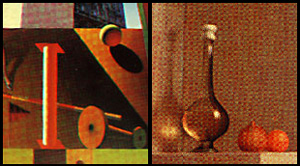|
|
MANIFESTO OF VISIONARY ART
|
different colour glazes. The unique result of such glazing is that the artist may create a multitude of colour combinations, not only through the effect of one colour beside the other ('traditional impressionism') but also on top of the other ('visionary impressionism'). Mixing such colours on the palette would result only in mud. But, sitting on top of one another on the canvas, they blend in the eye of the beholder to form new colours of incredible richness and depth, hitherto unseen in this world. Only in rare jewels, clear seas, crystals and other vision-inducing materials can those transluscent depths be experienced in the exterior world. But, the unique colours created through layering ultimately transcend that experience, and are to be found only in the interior world of our dreams, visions, and imagination.
As Fuchs recalls: "Hausner's contribution was to sharpen our awareness of colour through his many amiable critiques. He was able to demonstrate to us the many possibilities of polychromy and complementary colours, so that it became emminently clear how painting had evolved since the time of the Gothics." (104)
Before embarking on the path of Fantastic Realism, Rudolf Hausner had painted in a more traditional Impressionist style. As a result, he was able to apply Impressionest theories of Polychromy to the Mischtechnik. As Hausner recounts:
"The painting of the Old Masters proceeds from the local colour of the object... My painting proceeds from the colour spectrum... The Old Masters painted a red ball in local colour by using light red in the lights and dark red in the shadows. They knew the complementary effect of warm and cold in relation to light and shadow, and increased the volume of the object in this way.
"I paint a red ball using spectrum colours. For example, in the light, I put red-orange; on the shadow's border, I put violet; and in the
|
|
|
|
|

HAUSNER
VAN DER WEYDEN
|
back light, I use green. And in this way, the ball becomes red through the combined effect of all these colours working together. I did not discover polychromy - it came from spectrum analysis and was brought forward by the Impressionists."(105)
Particularly when the tonal value of the colours is very high in whites, a unique array of 'prismatic' colours may be achieved, such as one sees in nature through 'mother of pearl' seashells or reflected by the carpace of certain scarabs. As Terrence McKenna recounts, "The diffraction of light that occurs in natural phenomena such as rainbows, peacock feathers, certain insects, and the colours that appear on the surfaces of some metals during heating are persistent motifs within a particular stage of the alchemical opus. The cauda pavonis (the peacock's tail) is the brief stage that heralds the final whitening..."(106) As such, prismatic colours are found, ultimately, in the vision-quest - where a multiplicity of hightened colours may harmonize, blend, and ultimately unite into pure white light.
|
|
|
|
